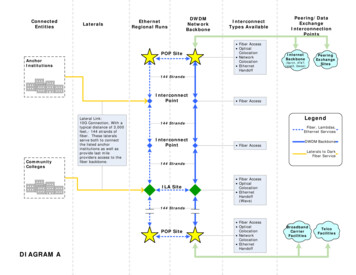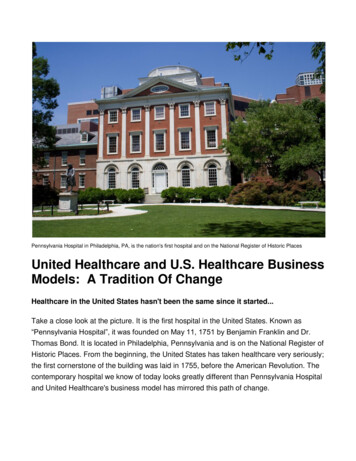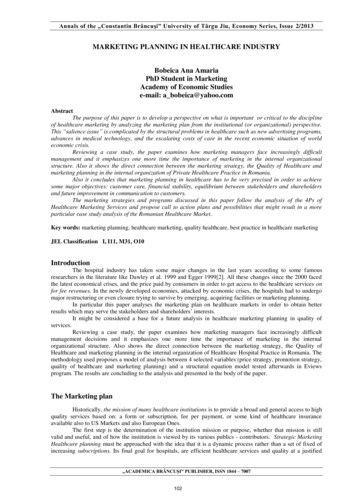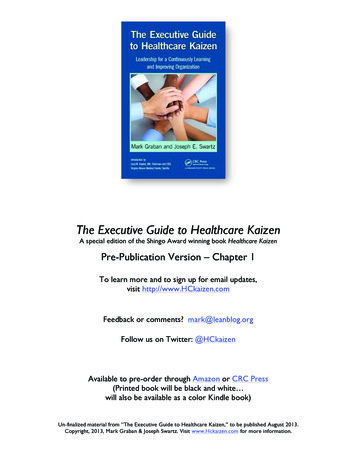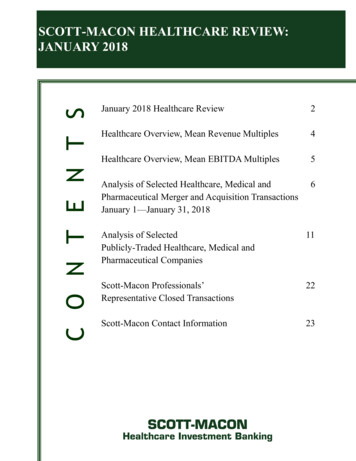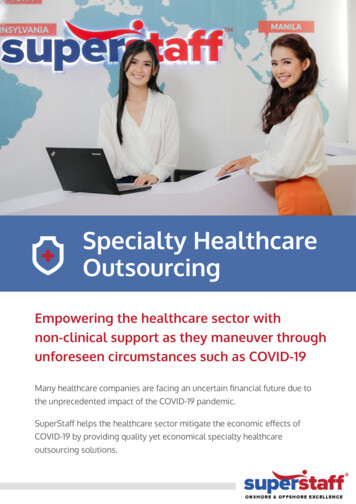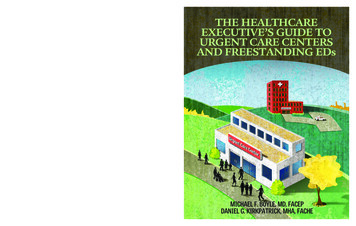
Transcription
Michael F. Boyle, MD, FACEPDaniel G. Kirkpatrick, MHA, FACHEOne in five Americans lacks adequate access to primary care physicians, and eventhose patients with insurance and a primary care doctor can struggle to get same-dayappointments, leaving many seeking treatment in overcrowded, high-cost emergencydepartments. Urgent care centers offer patients a lower-cost, convenient alternativeto hospitals. For providers, these centers represent new business opportunities.The Healthcare Executive’s Guide to Urgent Care Centers and Freestanding EDsoffers a step-by-step executive-level guide to planning, building, staffing, marketing,and managing profitable urgent care centers.This road map to urgent care centers and freestanding EDs will help you andyour organization: Create a financial plan Determine whether to lease or build Develop an efficient staffing model Effectively market the urgent care center Learn strategies to grow and expand the urgent care center’s servicesThe HealthcareExecutive’s Guide toUrgent Care Centersand Freestanding EDsBoyle / KirkpatrickFor more on HealthLeaders Media’s complete line of healthcare leadership resources,visit www.healthleadersmedia.com.The Healthcare Executive’s Guide toUrgent Care Centers and Freestanding EDsThe Healthcare Executive’sGuide to Urgent Care Centersand Freestanding EDsHCEGUCCFED75 Sylvan Street Suite A-101 Danvers, MA 01923www.hcmarketplace.comMichael F. Boyle, MD, FACEPDaniel G. Kirkpatrick, MHA, FACHE
The HealthcareExecutive’s Guideto urgent care centers and freestanding edsMICHAEL F. BOYLE, MD, FACEPDANIEL G. KIRKPATRICK, MHA, FACHE
The Healthcare Executive’s Guide to Urgent Care Centers and Freestanding EDs is published by HealthLeaders MediaCopyright 2012 HealthLeaders MediaAll rights reserved. Printed in the United States of America.5 4 3 2 1ISBN: 978-1-60146-933-5No part of this publication may be reproduced, in any form or by any means, without prior written consent ofHCPro, Inc., or the Copyright Clearance Center (978-750-8400). Please notify us immediately if you have receivedan unauthorized copy.HCPro, Inc., provides information resources for the healthcare industry.HCPro, Inc., is not affiliated in any way with The Joint Commission, which owns the JCAHO and Joint Commissiontrademarks.Michael F. Boyle, MD, FACEP, AuthorDoug Ponte, Cover DesignerDaniel G. Kirkpatrick, MHA, FACHE, AuthorMike Mirabello, Senior Graphic ArtistCarrie Vaughan, EditorMatt Sharpe, Production ManagerBob Wertz, Editorial DirectorShane Katz, Art DirectorMatt Cann, Group PublisherJean St. Pierre, Senior Director of OperationsAdvice given is general. Readers should consult professional counsel for specific legal, ethical, or clinical questions.Arrangements can be made for quantity discounts. For more information, contact:HCPro, Inc.75 Sylvan Street, Suite A-101Danvers, MA 01923Telephone: 800-650-6787 or 781-639-1872Fax: 800-639-8511Email: customerservice@hcpro.comHCPro, Inc., is the parent company of HealthLeaders Media.Visit HealthLeaders Media online at www.healthleadersmedia.com08/201221978
ContentsAbout the Authors. ixAcknowledgments. xiIntroduction.xiiiChapter 1: Healthcare Market for Urgent Care Centersand Freestanding EDs.1Changing Insurance Landscape.2Costs of Care.4Access to Care.6Defining Urgent Care Facilities.11ED and Urgent Care Interface.14Chapter 2: Affiliation and Ownership.21Business Case.21Urgent Care Models.23Independent Urgent Care Models.27Chapter 3: Creating a Financial Plan.31Market Considerations.31The Healthcare Executive’s Guide to Urgent Care Centers and Freestanding EDs 2012 HealthLeaders Mediaiii
ContentsFinancing 101.32Key Takeaway.35Chapter 4: Facility Considerations.37Location Is Crucial.38Lease vs. Ownership.42Defining Internal Spaces.44Equipment and Supply Needs.50Key Takeaway.54Chapter 5: Billing, Coding, Collections.57Insurance Participation Strategies.58Determining Which Payers to Work With.60Contract Negotiations.62Billing for Services.64Key Takeaway.69Chapter 6: Human Resources and Staffing.71Hiring the Right People.75Staffing Requirements.75Staffing Hours.79Staffing Based on Clinic Model.80ivThe Healthcare Executive’s Guide to Urgent Care Centers and Freestanding EDs 2012 HealthLeaders Media
ContentsChapter 7: Ancillary Testing: Laboratory and Radiology Services.85Determining What Laboratory Services to Provide.88Determining What Radiology Services to Provide.93Key Takeaway.98Chapter 8: Clinical Patient Care Services.99Types of Clinical Care Treated.100Medical Staff Issues.102Medical Emergencies.104A Few Clinical Pearls of Wisdom.108Key Takeaway.111Chapter 9: Patient Satisfaction: Creating and Delivering theRight Expectations.113The Cost of Dissatisfied Patients.116Improving Patient Satisfaction.120Specific Techniques to Satisfy Your Patients.123Quality Issues.127Key Takeaway.131Chapter 10: Marketing Strategies.133Tailoring the Marketing Message.134Building the Marketing Plan.139Marketing Basics.141Key Takeaway.142The Healthcare Executive’s Guide to Urgent Care Centers and Freestanding EDs 2012 HealthLeaders Mediav
ContentsChapter 11: Safety and Risk Management.143A Culture of Safety.143Catching the Errors.150Stay Focused on Ongoing Operations.154Chapter 12: Strategies to Expand Urgent Care Business.163Occupational Medicine.165Immunization Clinic.170Travel Medicine.172Physical Examinations.175Hospital-Affiliated Clinics.179Chapter 13: The Freestanding Emergency Department.181Principles of the Freestanding Emergency Department.181Access to Care.184Unique Challenges for the Freestanding Emergency Department.187Chapter 14: Retail Clinics.193Basics of Retail Clinics.193Key Takeaway.197viThe Healthcare Executive’s Guide to Urgent Care Centers and Freestanding EDs 2012 HealthLeaders Media
ContentsChapter 15: Urgent Care Centers as Part of AccountableCare Organizations.199ACO Concept.200ACO Structure.201Documentation and Electronic Health Records.203Urgent Centers and ACOs.205Key Takeaway.206Chapter 16: The Ideal Urgent Care Clinic.209Planning the “I Have a Dream” Clinic.209Appendix A.215Appendix B.221Appendix C.229Appendix D.231The Healthcare Executive’s Guide to Urgent Care Centers and Freestanding EDs 2012 HealthLeaders Mediavii
About the AuthorsMichael F. Boyle, MD, FACEPMichael F. Boyle, MD, FACEP, has spent more than 20 years practicing emergency medicine and managing emergency departments, fast track programs,occupational medicine programs, and urgent care centers. He is the regionalmedical director at Traverse City, Michigan–based Emergency Consultants, Inc.,managing sites in New York, Delaware, and Pennsylvania.Dr. Boyle has traveled extensively providing consultation for emergency department management, hospital wide flow improvement, and patient satisfaction. Hismain focus is hospital-affiliated programs for emergency services, occupationalmedicine, and urgent care. Dr. Boyle currently oversees three urgent care sites,and he will soon be opening an additional urgent care and free standing emergency department. Dr. Boyle received his degree from Eastern Virginia MedicalSchool in Norfolk, Virginia, and completed his emergency medicine residency atWright State University of Medicine in Dayton, Ohio.Daniel G. Kirkpatrick, MHA, FACHEDaniel G. Kirkpatrick, MHA, FACHE, has more than 30 years of healthcaremanagement experience in consulting, staff, and administrator roles. He leadsThe Healthcare Executive’s Guide to Urgent Care Centers and Freestanding EDs 2012 HealthLeaders Mediaix
About the Authorsclient services at BestPractices, Inc., an emergency medicine leadership and staffingpractice affiliate of EmCare. Mr. Kirkpatrick has extensive consulting experienceworking with group practices and hospitals in meeting operational/financial goals,as well as enhancing service, leadership, safety, and sustainability performance.Prior work experience in public accounting, administrative roles in hospitals(for-profit, nonprofit, specialty medical-surgical, and behavioral health), andextensive practice management for medical practices (primary care, specialty,and hospital-based) provide him sensitivity to the complex issues confronting healthcare providers. Dan holds a BA in Psychology from the College of Woosterand an MHA from The Ohio State University.Dan, his wife, and children live in eastern North Carolina.xThe Healthcare Executive’s Guide to Urgent Care Centers and Freestanding EDs 2012 HealthLeaders Media
AcknowledgmentsMany people have assisted in the production of this book and to all of you I amtruly grateful. I would like to specifically acknowledge Dr. Robert Williams,chairman of the board at Emergency Consultants Inc., who has always served as amentor and provided extensive education and advice on healthcare economics andthe political environment. Several colleagues provided specific information onstaffing, program expansion, and other topics. I would like to thank Dr. Jospuraand Dr. Richard Koehler, who serves as medical director for our urgent care sites,and Dr. Richard Conyers for his occupational medicine expertise. Several of oursite nurse managers provided information on staffing, supplies, and clinic start upincluding Ms. Lori Greeney from Oswego Health and Ms. Kristina Gambitta andMs. Amy Thomas, who are both from our programs with Cayuga Medical Center.In addition, I would like to thank John Fraley and Tammy Antoncic from SymMetrix Revenue Solutions for their assistance with billing and coding information. Iwould also like to thank Dan, my coauthor, for making this book possible, and forthe trips across the country providing facilities with our expertise.Finally, I am thankful for all of the blessings bestowed upon me and the love ofmy life, Bobbi (my wife), who has stood by me for more than 20 years, and mydaughters, Marcianna and Victoria, who have tolerated my many hours of workaway from home. Thank you and I love you all.—Michael F. Boyle, MD, FACEPThe Healthcare Executive’s Guide to Urgent Care Centers and Freestanding EDs 2012 HealthLeaders Mediaxi
AcknowledgmentsI’ve had the privilege of befriending and working with Mike Boyle over thepast six years, and a truer colleague doesn’t exist! Having this opportunity to collaborate on a work that “teases out” some of the nuances of this burgeoningfield of urgent care medicine has been wonderful.Special thanks to Jaime Vance, Mike Drinkwater, and the staff of Martin Gottlieband Associates for assisting with coding and billing, explaining the inherent complexities, and their willingness to participate in advancing this body of knowledge.I’m indebted to Drs. Kirk Jensen and Thom Mayer who have both whetted myappetite for emergency medicine service delivery and challenged me to neverforget that the patient always comes first.The steadfast support, understanding, and patience of a loving wife cannot beoverstated. This project was of particular interest because she offered her nursingperspective which was very helpful—thanks, Allison. Home base for me is myfamily and special thanks to my kids, of whom I am very proud: Dave and Dawn;Steven and Lindsay; Travis; Stephen; and Austin.A special thanks to my partners in Four Guys, a healthcare consulting venture—everyone needs differing perspectives to stay grounded and honest—and Dave,Tony, and Jim fill that bill very well!—Daniel G. Kirkpatrick, MHA, FACHExiiThe Healthcare Executive’s Guide to Urgent Care Centers and Freestanding EDs 2012 HealthLeaders Media
IntroductionThe intent of this book is to provide both the healthcare executive and entrepreneurial physician basic tools to research and consider implementing an urgentcare center. The following are the major aspects of urgent care centers covered inthis book: The major political changes leading to the development and rapidincrease of urgent care centers and freestanding emergency departments(ED) in the past five years The certificate of need and other statutes for the corporate practice ofmedicine regarding urgent care centers The different types of urgent care, including retail clinics, cash clinics,moderate- and high-level urgent care, and freestanding EDs, along withindications for the development of each The five basic reasons for a healthcare system to expand into the urgentcare market A step-by-step analysis of the urgent care business plan developmentprocess, urgent care site selection, and proforma developmentThe Healthcare Executive’s Guide to Urgent Care Centers and Freestanding EDs 2012 HealthLeaders Mediaxiii
Introduction The various staffing levels required based on the intent of the urgent caresite including medical technicians, licensed vocational nurses, registerednurses, nurse practitioners, and physicians The basic marketing plans and patient satisfaction methods to promotegrowth and volume for the site The benefits of developing a full-service occupational medicine program The methods for urgent care center expansion, such as the performance ofphysical examinations, travel medicine, and immunization clinics The unique challenges faced by freestanding EDsWe hope that this information provides adequate guidance for administrators inthe basic understanding of urgent care programs. In addition, we strive to providethe physician with necessary information for the development of an urgent caresite in the hope that appropriate planning leads to future success of the clinic.xivThe Healthcare Executive’s Guide to Urgent Care Centers and Freestanding EDs 2012 HealthLeaders Media
Chapter1Healthcare Market forUrgent Care Centers andFreestanding EDsHealthcare costs continue to escalate in both the public and private sectors.Reasons for this include the increased cost and availability of advanced technology(e.g., MRI, CT), poorly controlled costs with end-of-life care, overtesting byproviders due to fear of litigation, overtesting at the demand of the patient(e.g., MRI tests for back pain), fraud and abuse of Medicare/Medicaid, excessivecharges for prescription drugs, and cost shifting by hospitals to cover uninsuredand/or indigent care, among others.The economic downturn in 2008, starting with the collapse of the mortgageindustry, has resulted in further pressures on the U.S. healthcare system.For example, the unemployment rate was more than 9% in 2011,1 which leadto people losing healthcare coverage, delaying elective surgeries, and forgoingtreatment. The current economic climate has still not yielded answers or improvement to rising healthcare costs. U.S. companies continue to decreasereimbursement for healthcare coverage by increasing cost sharing (increasedcopays) with employees or eliminating coverage altogether.2The Healthcare Executive’s Guide to Urgent Care Centers and Freestanding EDs 2012 HealthLeaders Media1
Chapter 1As a result of these market pressures, the number of people without insurancehas escalated and will likely exceed 50 million in 2012.3 This number does notinclude people who are underinsured. A significant number of the uninsuredpopulation is probably unable to afford the average 1,500 per month cost ofinsurance. There is, however, a select population of young and healthy employedindividuals who elect not to purchase health insurance and play healthcareroulette by avoiding the premium expense.Changing Insurance LandscapeAs health insurance has gone from covering only catastrophic healthcare events,which are a large cause of financial ruin and bankruptcy in the United States, toroutine care, the general public has the expectation that there will be very littleout-of-pocket expense. But now, the pendulum is rapidly shifting to greater costsforced onto the consumer and away from the employer as companies eliminatecoverage or increase the portion employees pay.The original intent of insurance was the development of financial risk shiftingfrom the patient to the insurance carrier.4 Due to the economic conditions afterWorld War II, wage increases were frozen by the government, forcing employersto look for alternative incentives to improve a financial package for prospectiveemployees. This was the beginning of the provision of healthcare and otherbenefits as a means to supplement income, also known as the “fringe benefiterror.” Employer-sponsored health benefits were untaxed income to theemployee. But during the past few decades, insurance benefits have grownfrom simple catastrophic care to include routine physical exams, health2The Healthcare Executive’s Guide to Urgent Care Centers and Freestanding EDs 2012 HealthLeaders Media
Healthcare Market for Urgent Care Centers and Freestanding EDsscreenings, prescription drugs, and hospitalization. These added benefits comewith a cost to the purchaser of the policy: the employer.The cost of healthcare became too high for many employers to continue to footthe bill, in part because, with limited out-of pocket costs, consumers often utilizegreater healthcare services. The classic example of this trend is end-of-yearmedical care. After consumers have used up their annual health insurance deductible, they will try to schedule an elective surgery or colonoscopy screeningbecause of the decrease in the out-of-pocket costs they are responsible for oncetheir deductible has been met. If the procedure or test will not cost the consumermoney, utilization will likely be higher.Between 2000 and 2009, employer-sponsored private health insurance declined from67% to 58%.5 As a result, patients became more responsible for their personalhealthcare costs through increased copays, provision of their own insurance, orpaying out of pocket for healthcare services. It is likely that patients will be morediscriminating in expenditures when cost of care comes out of pocket versus from aninsurance company or government source. Part of the discrimination will includeboth cost and quality—especially as this type of information becomes more easilyaccessible and just a keystroke away on the Internet through the Hospital Compareand Hospital Consumer Assessment of Healthcare Provider and Systems websites.Patients are also becoming better-educated consumers of healthcare.Major purchasers of healthcare will begin to steer patients to more cost-effectivealternatives to receive care, such as urgent care centers versus hospital emergencydepartments (ED). One major change is the source of healthcare funding. In ourThe Healthcare Executive’s Guide to Urgent Care Centers and Freestanding EDs 2012 HealthLeaders Media3
Chapter 1experience as a large provider of emergency and urgent care services, 2011 wasthe first year that Medicare and Medicaid accounted for greater than 50% of allbilled patients, which means that the bulk of healthcare is financed by state andfederal resources. The majority of healthcare costs involves hospital care, physician/provider fees, and prescription drugs.Costs of CareMuch of our discussion reviews costs of care and patient charges. In this context,we use cost to identify how much it costs healthcare facilities to provide the care.From the patient aspect, we identify charges as the fee paid by the patient.In some cases, the cost of caring for a patient in urgent care clinics may be lowerand the charge to the patient for this care may also be lower in urgent careclinics. The reason for these differences in cost is most often related to the loweroverhead of these types of facilities (e.g., size of the facility and the cost of staffing). Retail clinics, for example, often have minimal space and are staffed bya single nurse practitioner resulting in both minimal costs and minimal charges.As urgent care clinics grow in complexity, from offering basic to advancedservices, the clinic must pay for additional office space and staffing requirements,such as clerical personnel, that result in both cost and charge increases. Obviously, staffing urgent care centers with physicians versus nurse practitionersor physician assistants is a more expensive alternative but would be required todeliver higher levels of care.4The Healthcare Executive’s Guide to Urgent Care Centers and Freestanding EDs 2012 HealthLeaders Media
Healthcare Market for Urgent Care Centers and Freestanding EDsWhen the urgent care center is affiliated with a hospital, it will often see and treatall patients (including Medicaid and self-pay) without collecting fees prior todelivery of services resulting in bad debt and cost shifting, whereas privatelyowned facilities sometimes do not accept Medicaid or self-pay patients unlesscash is paid up front.As we discuss later in Chapter 6, a major cost advantage of urgent care clinicsover EDs is the lack of overnight coverage. EDs must have the staff available24 hours per day, 7 days per week, which can be expensive when volumes aretypically lower from the hours of 2 a.m. until 7 a.m. Urgent care clinics areusually open during peak flow hours and benefit during the entire time of operations, which maximizes productivity and minimizes costs.A key point for both healthcare executives and governmental officials tounderstand, however, is the vital need for full-service, hospital-based EDs andthe unique reasons for differences in both facility cost and patient charges.The number of EDs in the United States continues to decline in the approximately 4,700 hospital-based facilities nationwide. According to USA Today,closures of nonrural EDs exceeded 27%, with a drop from 2,446 to 1,779from 1990 through 2009. 6 Yet, our nation’s EDs represent only 3% of thenational healthcare expenditure, which exceeds 2 trillion dollars.7 Thegeneral population, media, and politicians believe that EDs are expensiveplaces to receive care, but when you understand the fundamental staffing costsof an ED visit at 2 a.m., the marginal cost for an emergency visit is actuallyvery low. 8The Healthcare Executive’s Guide to Urgent Care Centers and Freestanding EDs 2012 HealthLeaders Media5
Chapter 1On the other hand, the cost to keep an urgent care clinic open past 11 p.m.may be too high to remain viable, suggesting that EDs are still the most viableoption in the late evening and early morning hours for some nonemergent cases. According to Robert Williams, MD, the marginal costs of care for minor patientinjuries are low in the ED.9 We firmly believe that both costs and charges fornonemergent cases can be reduced in urgent care clinics but argue that urgentcare centers that stay open 24 hours per day lose a significant component of costssavings and result in charge increases.Access to CareOne of the key challenges the U.S. healthcare industry grapples with is access tocare. There are roughly 50 million Americans who lack healthcare insurance.10Healthcare reform addresses this need and offers funding
Daniel G. KirKpatricK, Mha, Fache The healThcare execu Tive's Guide o urGenT care cenTers and FreesTandinG eds 75 Sylvan Street Suite A-101 Danvers, MA 01923 www.hcmarketplace.com The healThcare execuTive's Guide To urG encare ers and FreesTandinG eds Michael F. Boyle, MD, FACEP Daniel G. Kirkpatrick, MHA, FACHE



